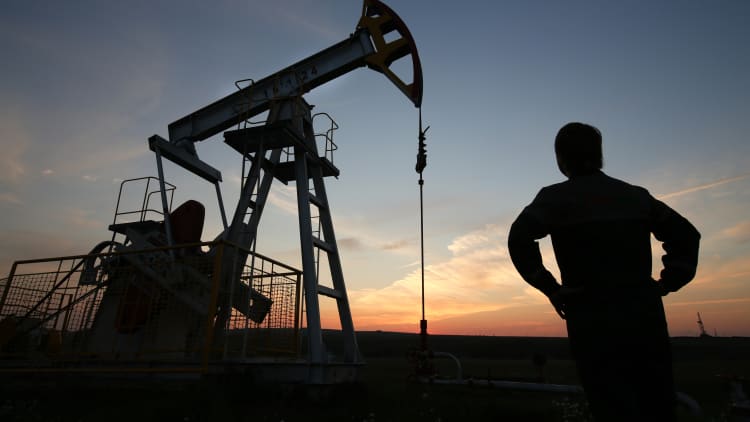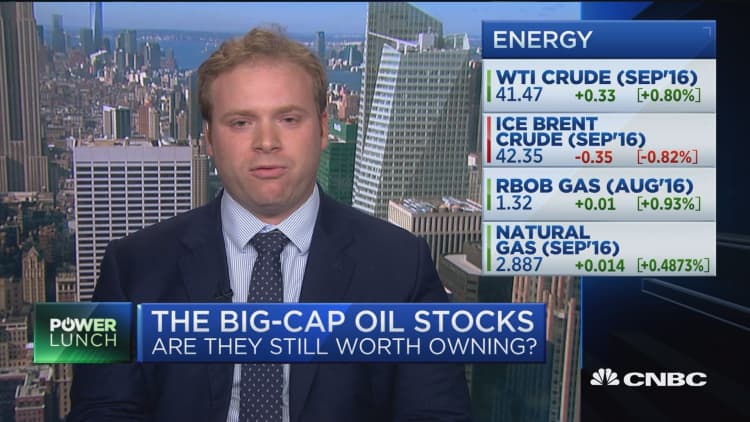
U.S. crude prices on Monday settled sharply lower after briefly breaking below $40 a barrel for the first time since April, weighed by a survey showing output in OPEC reached record highs last month amid the biggest addition of U.S. oil rigs in two years.
U.S. West Texas intermediate (WTI) ended 3.7 percent lower, or $1.54, at $40.06 — its lowest settlement since April 20 — after sliding as low as $39.86 just after midday.
Brent crude was down $1.34, or 3.1 percent, at $42.19 a barrel, after reaching an intraday low of $41.87.
Both benchmarks fell around 15 percent in July, with the decline being WTI's largest monthly drop in a year.
John Kilduff, founding partner at energy hedge fund Again Capital, said sentiment has turned decidedly negative, as evidenced by a rise in short positions in WTI futures and a "complete abandonment" of speculative long positions, said .
"It's built upon the glut that's out there that everyone thought was going to be clearing, but hasn't," he told CNBC.
"All the theses of the bulls in this market are becoming unwound," he said.

Production in July by the Organization of the Petroleum Exporting Countries likely rose to its highest in recent history, a Reuters survey found on Friday, as Iraq pumped more and Nigeria squeezed out additional crude exports despite militant attacks on oil installations.
Top OPEC exporter Saudi Arabia also kept output close to a record high, the survey found, as it met seasonally higher domestic demand and focused on maintaining market share instead of trimming supply to boost prices.
There are also signs Saudi Arabia is once again chasing market share. Saudi Aramco, the state-controlled oil company, cut its official selling price (OSP) for its benchmark Arab Light grade for September-loading cargoes by $1.30 a barrel to a discount of $1.10 to the regional marker Oman-Dubai.
U.S. oil drillers, meanwhile, added 44 rigs in July, the most in a month since April 2014, data from oil services company Baker Hughes showed.
On Monday, Iraqi oil officials said oil exports from Iraq's southern ports rose to 3.2 million barrels per day (bpd) on average in July, up from 3.175 million bpd in June, as the OPEC nation increased crude production.
Also on Monday, Iran's oil minister said the oil market was oversupplied but said balance between demand and supply will be restored, Iranian state television reported.
"Prices remain under pressure but we think they are likely to find a floor at around $40 and increase to $50 by the year end," Weinberg said.

French bank Societe Generale said that the global oil market has shifted from massive oversupply to broadly balanced in the second half of this year and first half of next year.
Analysts at the bank expect crude prices to bottom out in the high $30s and should not return to lows of $26-27 seen in the first quarter of this year.
Earlier on Monday, Barclays said Brent crude has averaged $46.50 in the third quarter so far and could fall further from current price levels.
The global glut of oil still weighs on the market and even though summer is a good time to make supply adjustments, it is already halfway over, the bank said in a research note.
"Demand growth remains lacklustre and has not made significant inroads to clear the inventory overhang for oil," Barclays said.
"With the macroeconomic picture worsening and Saudi Arabia unlikely to exhibit much restraint as Iran seeks incremental market share, refineries are going to find themselves in the line of fire," Barclays added.
— CNBC's Tom DiChristopher contributed to this story.

